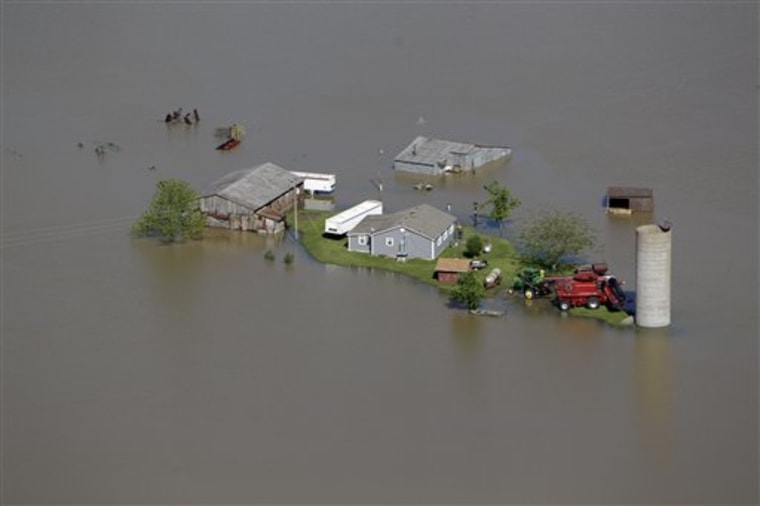Blasting open a levee and submerging more than 200 square miles of Missouri farmland has likely gouged away fertile topsoil, deposited mountains of debris to clear and may even hamper farming in some places for years, experts say.
The planned explosions this week to ease the Mississippi River flooding threatening the town of Cairo, Ill., appear to have succeeded — but their effects on the farmland, where wheat, corn and soybeans are grown — could take months or even years to become clear. The Missouri Farm Bureau said the damage will likely exceed $100 million for this year alone.
"Where the breach is, water just roars through and scours the ground. It's like pouring water in a sand pile. There is that deep crevice that's created," said John Hawkins, a spokesman for the Illinois Farm Bureau. "For some farmers, it could take a generation to recoup that area."
The issue is vital to farmers and the state of Missouri, whose attorney general repeatedly tried to block the U.S. Army Corps of Engineers' plan to break the levee. Opponents of the move argued it would leave the farmland buried under feet of sand and silt, rendering it useless for years.
It's still not clear how much damage the intentional flooding will cause and how farmers will be compensated for losses to the land and roughly 100 houses scattered through the area. Experts said the extent of the damage can't be accurately assessed until the floodwaters recede, and that likely will take months.
"It would be more toward the end of summer, early fall," said Maj. General Michael Walsh, the corps' commander and division engineer who made the final call to detonate the levee.
The river level itself is going to have to fall from its high flood stage before the water covering the fields can even begin to drain, said Jim Pogue, a corps spokesman. That could take a significant amount of time, he said.
"This is the greatest flood we've seen since 1937, we're tying records, breaking records, all down the river," Pogue said. "This is likely to be once-in-a-lifetime event."
After the first explosions Monday, rooftops could be spotted in the distance through binoculars. Tree limbs floating in the murky brown water and a few scattered cows left behind stood grazing on the sloping levee. As the swelling Mississippi flowed downriver, it was still too early to tell what the effect might be on farms further south.
Rick Cruse, an agronomy professor at Iowa State University and director of the university's Iowa Water Center, said farmers near the levees will find their topsoil has been washed away, and those farther away will have to deal with debris that has washed onto their land. Pollutants and chemicals in the water is another concern, but that threat is largely eased by the sheer volume of water that diluted those substances.
That water also likely removed any fertilizer that farmers applied to their fields last fall or earlier this spring.
"Odds are it will be gone," Cruse said.
Cruse said it is "highly unlikely" that Missouri farmers whose land was flooded will get a crop in the ground this year, but they should be able to return to the fields next year. Blake Hurst president of the Missouri Farm Bureau said damage will likely exceed $100 million for this year alone.
Joe Zumwalt, a western Illinois farmer whose land near Warsaw was flooded in 1993 and 2008 by the Mississippi River, knows what the Missouri farmers are facing.
"Immense pressure of the water just gorges out a lake and large amounts of ground will physically be gone," he said about farmland closest to the levee breach.
For those further inland, there will be a lot of debris to clean up.
"Homes, grain bins, machine sheds, anything that floats is floating around out there," said Zumwalt. "It's amazing to find what floats. I even found bricks."
Zumwalt said while this year may be lost, farmers should be optimistic about returning to the fields in 2012.
"It took some effort, but we were able to do it," said Zumwalt.
Ray Presson, whose land is five miles from where the levee was breached, said he has 2,400 acres now under water and the 550 acres of wheat he had planted is gone. He estimated his losses at more than $1.2 million. He's given up on plans to plant 600 acres, or nearly a square mile, of corn, which would have to be planted my late May to avoid major yield losses.
Although Army Corps officials predict it will be months before the water drains away, Presson remains hopeful he can plant some soybeans, which can be planted as late as mid-July.
"It won't be a top-yield crop," he said, "but we could get something and something is better than nothing."
Presson said he expects federal crop insurance and other aid to offset some of his losses, but he doesn't know how much help to expect.
Hurst said that in addition to crop insurance and federal disaster assistance, farmers might be eligible for funds to help restore their land and get it ready for planting next spring — if the government has the money.
Zumwalt said crop insurance was key to his ability to keep farming corn and soybeans on 4,500 acres that has been in his family since the 1930s. The insurance didn't replace his lost profits, but it was enough to let him make it to another season.
"If crop insurance wasn't available, I wouldn't be farming today," Zumwalt said.
